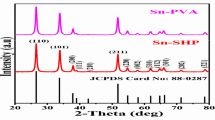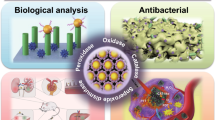Abstract
Nanoporous Au shows the antimicrobial activity without the release of ROS. The cell wall is hyperpolarized by npAu. Hence, the hyperpolarized cell wall may affect ATP synthase, leading to the bacterial death. In the present work, the effects of the hyperpolarized cell wall on the structure and functions of Asp61 in ATP synthase are investigated by molecular dynamics simulations and first-principles calculations. The simulations suggest that the Asp61 is more negatively hyperpolarized, which is due to the strengthened O-H bond in Asp61, in interacting with the hyperpolarized cell wall, which results in the disturbance of proton transport in ATP synthase.




Similar content being viewed by others
References
S. Sadhasivam, P. Shanmugam, M. Veerapandian, R. Subbiah, and K. Yun: Biogenic synthesis of multidimensional gold nanoparticles assisted by Streptomyces hygroscopicus and its electrochemical and antibacterial properties. Biometals 25, 351–360 (2012).
Y. Cui, Y. Zhao, Y. Tian, W. Zhang, X. Lu, and X. Jiang: The molecular mechanism of action of bactericidal gold nanoparticles on Escherichia coli. Biomaterials 33, 2327–2333 (2012).
Y. Zhang, H. Peng, W. Huang, Y. Zhou, and D. Yan: Facile preparation and characterization of highly antimicrobial colloid Ag or Au nanoparticles. J. Colloid Interface Sci. 325, 371–376 (2008).
D. Sabert, S. Engelbrecht, and W. Junge: Intersubunit rotation in active F-ATPase. Nature 381, 623–625 (1996).
H. Noji, R. Yasuda, M. Yoshida, and K. Kinosita Jr.: Direct observation of the rotation of F1-ATPase. Nature 386, 249–302 (1997).
J.L. Martin, R. Ishmukhametov, D. Spetzler, T. Hornung, and W.D. Frasch: Elastic coupling power stroke mechanism of the F1-ATPase molecular motor. Proc. Natl. Acad. Sci. USA 115, 5750–5755 (2018).
B. Galeano, E. Korff, and W.L. Nicholson: Inactivation of vegetative cells, but not spores, of Bacillus anthracis, B. cereus, and B. subtilis on stainless steel surfaces coated with an antimicrobial silver- and zinc-containing zeolite formulation. Appl. Environ. Microbiol. 69, 4329–4331 (2003).
F.U. Khan, Y. Chen, N.U. Khan, A. Ahmad, K. Thahir, Z.U. Khan, A.U. Khan, S.U. Khan, M. Raza, and P. Wan: Visible light inactivation of E. coli, cytotoxicity and ROS determination of biochemically capped gold nanoparticles. Microb. Pathog. 107, 419–427 (2017).
G. Zhao and S.E. Stevens Jr.: Multiple parameters for the comprehensive evaluation of the susceptibility of Escherichia coli to the silver ion. BioMetals 11, 27–32 (1998).
M. Hakamada, S. Taniguchi, and M. Mabuchi: Antibacterial activity of nanoporous gold against Escherichia coli and Staphylococcus epidermidis. J. Mater. Res. 32, 1787–1795 (2017).
N. Miyazawa, M. Hakamada, and M. Mabuchi: Antibacterial mechanisms due to hyperpolarization induced by nanoporous Au. Sci. Rep. 8, 3870, 1–8 (2018).
A.P. Srivastava, M. Luo, W. Zhou, J. Symersky, D. Bai, M.G. Chambers, J.D. Faraldo-Gómez, M. Liao, and D.M. Mueller: High-resolution cryo-EM analysis of the yeast ATP synthase in a lipid membrane. Science 360 (2018). doi: 10.1126/science.aas9699.
P.D. Boyer: The ATP synthase – a splendid molecular machine. Annu. Rev. Microbiol. 66, 717–749 (1997).
G. Deckers-Hebestreit and K. Altendorf: The F0F1-type ATP synthesis of bacteria: structure and function of the F0 complex. Annu. Rev. Microbiol. 50, 791–824 (1996).
R.H. Fillingame: Coupling H+ transport and ATP synthesis in F1F0-ATP synthases: glimpses of interacting parts in a dynamic molecular machine. J. Exp. Biol. 200, 217–224 (1997).
R.H. Fillingame: The Bacteria, Vol. 2 (Academic, New York, 1990) pp. 345–391.
T.M. Duncan, V.V. Bulygin, Y. Zhou, M.L. Hutcheon, and R.L. Cross: Rotation of subunits during catalysis by Escherichia coli F1-ATPase. Proc. Natl. Acad. Sci. USA 92, 10964–10968 (1995).
J. Czub and H. Grubmüller: Torsional elasticity and energetics of F1-ATPase. Proc. Natl. Acad. Sci. USA 108, 7408–7413 (2011).
W. Jiang and F.H. Robert: Interacting helical faces of subunits a and c in the F1F0 ATP synthase of Escherichia coli defined by disulfide cross-linking. Proc. Natl. Acad. Sci. USA 95, 6607–6612 (1998).
H. Gohlke, D. Schlieper, and G. Growth: Resolving the negative potential side (n-side) water-accessible proton pathway of F-type ATP synthase by molecular dynamics simulations. J. Biol. Chem. 287, 36536–36543 (2012).
R.H. Fillingame and P. Ryan Steed: Half channels mediating H+ transport and the mechanism of gating in the F0 sector of Escherichia coli F1F0 ATP synthase. Biochim. Biophys. Acta 1837, 1063–1068 (2014).
M. Sobti, C. Smits, A.S.W. Wong, R. Ishmukhametov, D. Stock, S. Sandin, and A.G. Stewart: Cryo-EM structures of the autoinhibited E. coli ATP synthase in three rotational states. eLife 5, e21598 (2016).
Y.-S. Lin, J.-H. Lin, and C.-C. Chang: Molecular dynamics simulations of the rotary motor F0 under external electric fields across the membrane. Biophys. J. 98, 1009–1017 (2010).
A.D. MacKerell Jr., D. Bashford, M. Bellott, R.L. Dunbrack Jr., J.D. Evanseck, M.J. Field, S. Fischer, J. Gao, H. Guo, S. Ha, D. Joseph-McCarthy, L. Kuchnir, K. Kuczera, F.T.K. Lau, C. Mattos, S. Michnick, T. Ngo, D.T. Nguyen, B. Prodhom, W.E. Reiher, B. Roux, M. Schlenkrich, J.C. Smith, R. Stote, J. Straub, M. Watanabe, J. Wiorkiewicz-Kuczera, D. Yin, and M. Karplus: All-atom empirical potential for molecular modeling and dynamics studies of proteins. J. Phys. Chem. B 102, 3586–3616 (1998).
D.V.D. Spoel, E. Lindahl, B. Hess, G. Groenhof, A.E. Mark, and H.J.C. Berendsen: GROMACS: fast, flexible, and free. J. Comput. Chem. 26, 1701–1718 (2005).
M.J. Abraham, T. Murtola, R. Schulz, S. Palla, J.C. Smith, B. Hess, and E. Lindahl: GROMACS: high performance molecular simulations through multi-level parallelism from laptops to supercomputers. Software X 1–12, 19–25 (2015).
B.J. Delley: An all-electron numerical method for solving the local density functional for polyatomic molecules. J. Chem. Phys. 92, 508–517 (1990).
B. J. Delley: From molecules to solids with the Dmol3 approach. J. Chem. Phys. 113, 7756–7764 (2000).
J.P. Perdew, J.A. Chevary, S.H. Vosko, K.A. Jackson, M.R. Pederson, D.J. Singh, and C. Fiolhais: Atoms, molecules, solids, and surfaces: application of the generalized approximation for exchange and correlation. Phys. Rev. B 46, 6671–6687 (1992).
M. Kobayashi, A.V. Struts, T. Fujiwara, M.F. Brown, and H. Akutsu: Fluid mechanical matching of H+-ATP synthase subunit c-ring with lipid membranes revealed by 2H solid-state NMR. Biophys. J. 94, 4339–4347 (2008).
S. Mukherjee and A. Warshel: Realistic simulations of the coupling between the protomotive force and the mechanical rotation of the F0-ATPase. Proc. Natl. Acad. Sci. USA 109, 14876–14881 (2012).
D. Pogoryelova, A.L. Klyszejkoa, G.O. Krasnoselskaa, E.-M. Hellera, V. Leonec, J.D. Langerd, J. Voncka, D.J. Müllere, J.D. Faraldo-Gómezc, and T. Meiera: Engineering rotor ring stoichiometries in the ATP synthase. Proc. Natl. Acad. Sci. USA 109, 9676–9677 (2012).
B.J. Murphy, N. Klusch, J. Langer, D.J. Mills, Ö Yildiz, and W. Kühlbrandt: Rotary substates of mitochondrial ATP synthase reveal the basis of flexible F1-F0 coupling. Science 364, 1155 (2019).
Acknowledgment
N.M. acknowledges support from the Grant-in-Aid for JSPS Fellows.
Author information
Authors and Affiliations
Corresponding author
Electronic supplementary material
Supplementary material
Supplementary material
The supplementary material for this article can be found at https://doi.org/10.1557/mrc.2020.8.
Rights and permissions
About this article
Cite this article
Miyazawa, N., Hakamada, M. & Mabuchi, M. Effects of nanoporous Au on ATP synthase. MRS Communications 10, 173–178 (2020). https://doi.org/10.1557/mrc.2020.8
Received:
Accepted:
Published:
Issue Date:
DOI: https://doi.org/10.1557/mrc.2020.8




